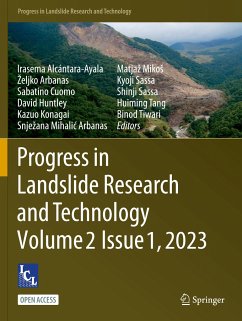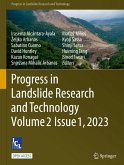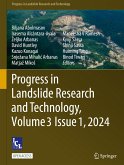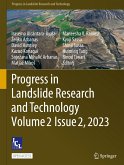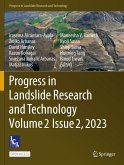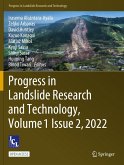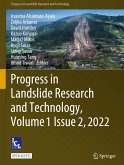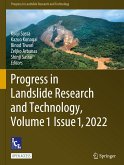Progress in Landslide Research and Technology, Volume 2 Issue 1, 2023
Herausgegeben:Alcántara-Ayala, Irasema; Arbanas, Zeljko; Cuomo, Sabatino; Huntley, David; Konagai, Kazuo; Mihalic Arbanas, Snjezana; Mikos, Matjaz; Sassa, Kyoji; Sassa, Shinji; Tang, Huiming; Tiwari, Bin
Progress in Landslide Research and Technology, Volume 2 Issue 1, 2023
Herausgegeben:Alcántara-Ayala, Irasema; Arbanas, Zeljko; Cuomo, Sabatino; Huntley, David; Konagai, Kazuo; Mihalic Arbanas, Snjezana; Mikos, Matjaz; Sassa, Kyoji; Sassa, Shinji; Tang, Huiming; Tiwari, Bin
- Broschiertes Buch
- Merkliste
- Auf die Merkliste
- Bewerten Bewerten
- Teilen
- Produkt teilen
- Produkterinnerung
- Produkterinnerung
This open access book provides an overview of the progress in landslide research and technology and is part of a book series of the International Consortium on Landslides (ICL). The book provides a common platform for the publication of recent progress in landslide research and technology for practical applications and the benefit for the society contributing to the Kyoto Landslide Commitment 2020, which is expected to continue up to 2030 and even beyond to globally promote the understanding and reduction of landslide disaster risk, as well as to address the 2030 Agenda Sustainable Development Goals. …mehr
Andere Kunden interessierten sich auch für
![Progress in Landslide Research and Technology, Volume 2 Issue 1, 2023 Progress in Landslide Research and Technology, Volume 2 Issue 1, 2023]() Progress in Landslide Research and Technology, Volume 2 Issue 1, 202339,99 €
Progress in Landslide Research and Technology, Volume 2 Issue 1, 202339,99 €![Progress in Landslide Research and Technology, Volume 3 Issue 1, 2024 Progress in Landslide Research and Technology, Volume 3 Issue 1, 2024]() Progress in Landslide Research and Technology, Volume 3 Issue 1, 202440,99 €
Progress in Landslide Research and Technology, Volume 3 Issue 1, 202440,99 €![Progress in Landslide Research and Technology, Volume 2 Issue 2, 2023 Progress in Landslide Research and Technology, Volume 2 Issue 2, 2023]() Progress in Landslide Research and Technology, Volume 2 Issue 2, 202339,99 €
Progress in Landslide Research and Technology, Volume 2 Issue 2, 202339,99 €![Progress in Landslide Research and Technology, Volume 2 Issue 2, 2023 Progress in Landslide Research and Technology, Volume 2 Issue 2, 2023]() Progress in Landslide Research and Technology, Volume 2 Issue 2, 202331,99 €
Progress in Landslide Research and Technology, Volume 2 Issue 2, 202331,99 €![Progress in Landslide Research and Technology, Volume 1 Issue 2, 2022 Progress in Landslide Research and Technology, Volume 1 Issue 2, 2022]() Progress in Landslide Research and Technology, Volume 1 Issue 2, 202233,99 €
Progress in Landslide Research and Technology, Volume 1 Issue 2, 202233,99 €![Progress in Landslide Research and Technology, Volume 1 Issue 2, 2022 Progress in Landslide Research and Technology, Volume 1 Issue 2, 2022]() Progress in Landslide Research and Technology, Volume 1 Issue 2, 202241,99 €
Progress in Landslide Research and Technology, Volume 1 Issue 2, 202241,99 €![Progress in Landslide Research and Technology, Volume 1 Issue 1, 2022 Progress in Landslide Research and Technology, Volume 1 Issue 1, 2022]() Progress in Landslide Research and Technology, Volume 1 Issue 1, 202242,99 €
Progress in Landslide Research and Technology, Volume 1 Issue 1, 202242,99 €-
-
-
This open access book provides an overview of the progress in landslide research and technology and is part of a book series of the International Consortium on Landslides (ICL). The book provides a common platform for the publication of recent progress in landslide research and technology for practical applications and the benefit for the society contributing to the Kyoto Landslide Commitment 2020, which is expected to continue up to 2030 and even beyond to globally promote the understanding and reduction of landslide disaster risk, as well as to address the 2030 Agenda Sustainable Development Goals.
Produktdetails
- Produktdetails
- Progress in Landslide Research and Technology
- Verlag: International Consortium on Landslides / Springer / Springer Nature Switzerland / Springer, Berlin
- Artikelnr. des Verlages: 978-3-031-39014-2
- 1st ed. 2023
- Seitenzahl: 496
- Erscheinungstermin: 25. Dezember 2023
- Englisch
- Abmessung: 279mm x 210mm x 27mm
- Gewicht: 1197g
- ISBN-13: 9783031390142
- ISBN-10: 3031390148
- Artikelnr.: 68288721
- Herstellerkennzeichnung Die Herstellerinformationen sind derzeit nicht verfügbar.
- Progress in Landslide Research and Technology
- Verlag: International Consortium on Landslides / Springer / Springer Nature Switzerland / Springer, Berlin
- Artikelnr. des Verlages: 978-3-031-39014-2
- 1st ed. 2023
- Seitenzahl: 496
- Erscheinungstermin: 25. Dezember 2023
- Englisch
- Abmessung: 279mm x 210mm x 27mm
- Gewicht: 1197g
- ISBN-13: 9783031390142
- ISBN-10: 3031390148
- Artikelnr.: 68288721
- Herstellerkennzeichnung Die Herstellerinformationen sind derzeit nicht verfügbar.
Prof. Irasema Alcántara-Ayala is a former Director and current Professor at the Institute of Geography of the National Autonomous University of Mexico (UNAM). She is a member of the UNDRR R-STAG of the Americas and an Editor of the ICL book series P-LRT. Prof. eljko Arbanas is the Vice President of the ICL for Europe. He is a professor at the Faculty of Engineering, University of Rijeka, Croatia. He is an Assistant Editor-in-Chief of the International Journal Landslides and the ICL book series P-LRT. Prof. Sabatino Cuomo Sabatino Cuomo is a Professor of Geotechnical Engineering at the University of Salerno and Coordinator of LARAM School (International School on "LAndslide Risk Assessment and Mitigation) for Ph.D. students. He is an Editor of the ICL book series P-LRT. Dr. David Huntley is Research Scientist with the Geological Survey of Canada and Open Learning Faculty at Thompson Rivers University, British Columbia. He is an Editor of the ICL book series P-LRT. Prof. Kazuo Konagai is a Professor Emeritus at the University of Tokyo and Principal Researcher of the ICL headquarters. He is an Assistant Editor-in-Chief of the ICL book series P-LRT. Prof. Snjeana Mihali¿ Arbanas a Professor of the Faculty of Mining, Geology and Petroleum, University of Zagreb in Croatia. She is the Chair of ICL Network Committee. Matja Miko, Professor at the Faculty of Civil and Geodetic Engineering, University of Ljubljana, Slovenia, is the Chairman of the Global Promotion Committee of the International Programme on Landslides and Kyoto Landslide Commitment 2020. Prof. Kyoji Sassa is the Founding President and the Secretary General of the ICL and the Secretary General of the Kyoto Landslide Commitment 2020. He is the Editor-in-Chief of the International Journal Landslides and the ICL book series P-LRT. Dr. Shinji Sassa is the Head of Soil Dynamics Group and Research Director at Port and Airport Research Institute, National Institute of Maritime, Port and Aviation Technology, Japan. He is an Editor of the International Journal Landslides and the ICL book series P-LRT. Prof. Huiming Tang is the Vice President of China University of Geosciences (Wuhan) and a Chief Professor at the Faculty of Engineering. He is a full member of ICL, Chairman of the Engineering Geology commission of China and Vice President of IAEG. Prof. Binod Tiwari is the Vice President of the ICL for America. He is a professor of civil and environment engineering at the California State University, Fullerton California, USA. He is an Assistant Editor-in-Chief of the ICL book series P-LRT.
Part I: ICL Landslide Lesson.- Sliding-surface liquefaction and undrained steady-state shear strength.- Identification and Mitigation of Reservoir Landslides Cases Studied in the Three Gorges Reservoir Area of China.- Part II: Original articles.- Impact of input data on the quality of the landslide susceptibility large-scale maps: A case study from NW Croatia.- Landslide warning systems in high-income countries: past accomplishments and expected endeavours.- Modelling of Landslide-Structure Interaction (LSI) through Material Point Method (MPM).- Landslide Research and Technology in International Standards.- Mathematical and numerical modeling of slope stability for the Mong Sen landslide event in the Trung Chai commune, Sapa, Vietnam.- Landslide early warning system based on the empirical approach - Case study in Ha Long City (Vietnam).- The modern activity of the Buzulgan landslide and its influence on the debris flow hazard for the Tyrnyauz town (Northern Caucasus, Russia).- A risk evaluation method of unstable slopes using multipoint tilting sensors.- Part III: IPL/WCOE/KLC2020.- Community Level Slope Disaster Risk Reduction Program through Multi-Scale Mapping by Mountain Ethnic Group in Northern Vietnam - Project Study by JICA / Lao Cai DARD / ITST.- Landslide Risk Assessment in the tropical zone of Vietnam as a contribution to the mitigation of natural disaster vulnerability.- Protection and conservation of Georgian rupestrian cultural heritage sites: a review.- Spatial and temporal characterization of landslide deformation pattern with Sentinel-1.- Lessons from 2019-2020 landslide risk assessment in an urban area of volcanic soils in Pereira-Colombia.- Part IV: ICL Landslide Teaching Tools.- Zonation of landslide susceptibility in the Gipuzkoa province (Spain): an application of LAND-SUITE.- Landslide and soil erosion inventory mapping based on high-resolution remote sensing data: A case study from Istria (Croatia).- Part V: Technical Notes and Case Studies.- Landslide monitoring with RADARSAT Constellation Mission InSAR, RPAS-derived point-clouds and RTK GNSS time-series in the Thompson River Valley, British Columbia, Canada.- Digital terrain models derived from unmanned aerial vehicles and landslide susceptibility.- Use of GIS to assess susceptibility per landform unit to gravitational processes and their volume.
Part I: ICL Landslide Lesson.- Sliding-surface liquefaction and undrained steady-state shear strength.- Identification and Mitigation of Reservoir Landslides Cases Studied in the Three Gorges Reservoir Area of China.- Part II: Original articles.- Impact of input data on the quality of the landslide susceptibility large-scale maps: A case study from NW Croatia.- Landslide warning systems in high-income countries: past accomplishments and expected endeavours.- Modelling of Landslide-Structure Interaction (LSI) through Material Point Method (MPM).- Landslide Research and Technology in International Standards.- Mathematical and numerical modeling of slope stability for the Mong Sen landslide event in the Trung Chai commune, Sapa, Vietnam.- Landslide early warning system based on the empirical approach - Case study in Ha Long City (Vietnam).- The modern activity of the Buzulgan landslide and its influence on the debris flow hazard for the Tyrnyauz town (Northern Caucasus, Russia).- A risk evaluation method of unstable slopes using multipoint tilting sensors.- Part III: IPL/WCOE/KLC2020.- Community Level Slope Disaster Risk Reduction Program through Multi-Scale Mapping by Mountain Ethnic Group in Northern Vietnam - Project Study by JICA / Lao Cai DARD / ITST.- Landslide Risk Assessment in the tropical zone of Vietnam as a contribution to the mitigation of natural disaster vulnerability.- Protection and conservation of Georgian rupestrian cultural heritage sites: a review.- Spatial and temporal characterization of landslide deformation pattern with Sentinel-1.- Lessons from 2019-2020 landslide risk assessment in an urban area of volcanic soils in Pereira-Colombia.- Part IV: ICL Landslide Teaching Tools.- Zonation of landslide susceptibility in the Gipuzkoa province (Spain): an application of LAND-SUITE.- Landslide and soil erosion inventory mapping based on high-resolution remote sensing data: A case study from Istria (Croatia).- Part V: Technical Notes and Case Studies.- Landslide monitoring with RADARSAT Constellation Mission InSAR, RPAS-derived point-clouds and RTK GNSS time-series in the Thompson River Valley, British Columbia, Canada.- Digital terrain models derived from unmanned aerial vehicles and landslide susceptibility.- Use of GIS to assess susceptibility per landform unit to gravitational processes and their volume.

